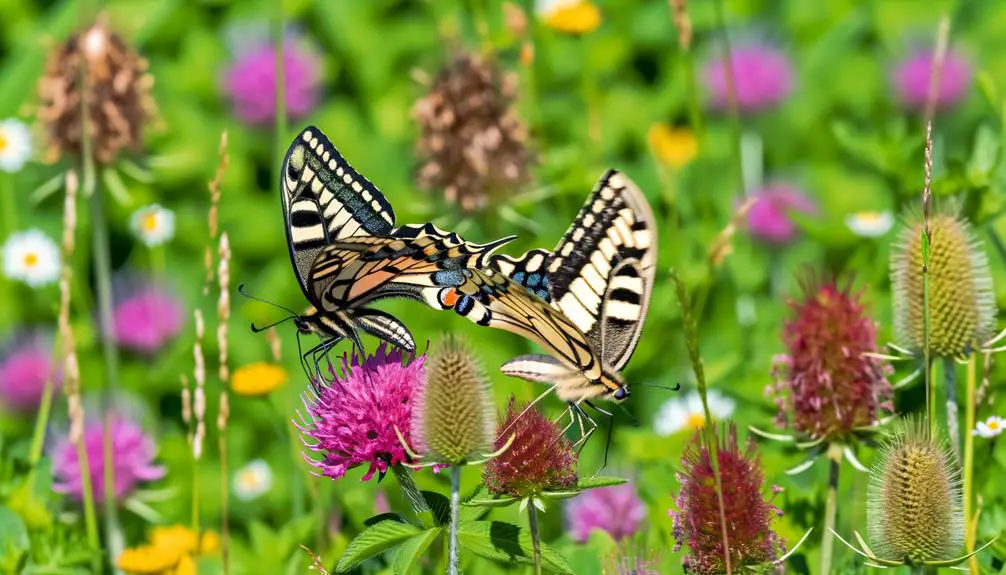What Distinguishes Male Vs Female Swallowtail Butterfly?
Male and female swallowtail butterflies exhibit marked sexual dimorphism, particularly in wing morphology and pigmentation. Males typically possess narrower, elongated wings optimized for territorial defense and exhibit brighter coloration for sexual selection.
Females, on the other hand, have broader wings which facilitate fecundity and cryptic patterns for predator evasion. Behaviorally, males are territorial and primarily forage for nectar, while females focus on host plant selection for oviposition.
These distinctions reflect evolutionary strategies tailored for maximizing reproductive success. Detailed exploration of these adaptations reveals the intricate balance between survival and reproduction in swallowtail butterflies.

Key Takeaways
- Males have narrower, elongated wings for territorial defense; females have broader wings for egg-laying efficiency.
- Males exhibit vivid coloration for sexual selection, while females have cryptic patterns for predator evasion.
- Males are more territorial and defend prime locations; females selectively forage for ideal host plants.
- Males engage in complex courtship displays using flight patterns and pheromones; females choose mates based on vigor.
Physical Appearance

Swallowtail butterflies exhibit distinct morphological features, including large, colorful wings with unique tail-like extensions on their hindwings. These extensions, scientifically referred to as caudal appendages, play a critical role in predator deterrence by mimicking antennae.
Male and female swallowtails demonstrate sexual dimorphism, which is evident in size and other structural attributes. Males typically possess narrower, more elongated wings, optimizing their flight capabilities for territorial defense and mate location.
Females, conversely, often exhibit broader wings, which may enhance their fecundity by facilitating efficient egg-laying. Additionally, males display a more streamlined thorax and abdomen, enhancing aerodynamic efficiency.
This dimorphic distinction underscores evolutionary adaptations tailored to the differing reproductive roles and ecological interactions of each sex within the species.
Wing Patterns
Beyond their morphological distinctions, the intricate wing patterns of swallowtail butterflies serve both ecological and evolutionary functions, providing camouflage, mate attraction, and species identification.
Male swallowtails typically exhibit more vivid and contrasting coloration, which plays a role in sexual selection by attracting potential mates. Females, on the other hand, often have more subdued, cryptic patterns that enhance their ability to evade predators, especially during oviposition.
The differential pigmentation is regulated by genetic and epigenetic factors, leading to variations in melanin and structural coloration. Additionally, the arrangement of spots, bands, and other pattern elements can vary between sexes, aiding in conspecific recognition and reducing interspecific competition.
These wing pattern adaptations underscore the complexity of lepidopteran evolutionary strategies.
Behavioral Traits

The behavioral traits of swallowtail butterflies exhibit a range of complex activities, including territoriality, courtship displays, and specific foraging strategies, which are critical for their survival and reproductive success.
Males are often observed engaging in territoriality, aggressively defending prime locations to attract females. This behavior is marked by frequent patrolling and aerial duels with rival males.
Females, on the other hand, display selective foraging behavior, focusing on locating ideal host plants for oviposition.
Both genders exhibit intricate courtship displays involving flight patterns and pheromone release to facilitate mate attraction.
Foraging strategies vary between the sexes; males prioritize nectar sources to maintain energy levels for territorial defense, while females allocate more time to host plant selection for egg-laying.
Mating Habits
Understanding the behavioral traits of swallowtail butterflies provides a foundation for examining their mating habits, which encompass intricate courtship rituals and reproductive strategies.
Male swallowtails often exhibit territoriality, engaging in aerial displays to attract females and ward off rivals.
Females, in turn, exhibit selective mate choice, often influenced by the male's vigor and territory quality.
The courtship process includes pheromone signaling and visual cues, which are critical for successful mating.
Post-copulatory behavior involves oviposition, where females strategically lay eggs on host plants to optimize larval survival.
The reproductive strategies of both sexes contribute to genetic diversity and species propagation, showcasing a complex interplay of biological and environmental factors.
Role in Ecosystem

Swallowtail butterflies play an essential role in their ecosystems by serving as pollinators and as a food source for various predators, thereby contributing to both plant reproduction and the food web.
Their interaction with flora and fauna fosters ecological balance, enhancing biodiversity.
The differences between male and female swallowtail butterflies can influence their specific ecological roles: For example, the giant swallowtail male vs female butterflies may exhibit differences in size, coloring, and flight patterns, which can impact their interactions with predators and pollinators. Males often patrol larger territories in search of mates, while females focus on locating suitable host plants for egg-laying. These behavioral distinctions contribute to the overall survival and reproductive success of the species.
- Pollination Efficiency: Males often visit more flowers due to their active search for mates, potentially enhancing pollination rates.
- Predation Rates: Females, being generally larger, may offer a more substantial food source for predators, impacting predator-prey dynamics.
Such roles underscore their integral presence in maintaining ecosystem stability and resilience.
Conclusion
Juxtaposing male and female swallowtail butterflies reveals distinct differences in physical appearance, wing patterns, behavioral traits, and mating habits, while their roles in the ecosystem remain interlinked.
Males often exhibit brighter coloration and more aggressive courtship behaviors, whereas females display cryptic wing patterns and selective mating strategies.
Despite these differences, both sexes contribute equally to pollination and biodiversity.
This dichotomy underscores the complexity of sexual dimorphism and its implications for ecological interactions and evolutionary processes.






